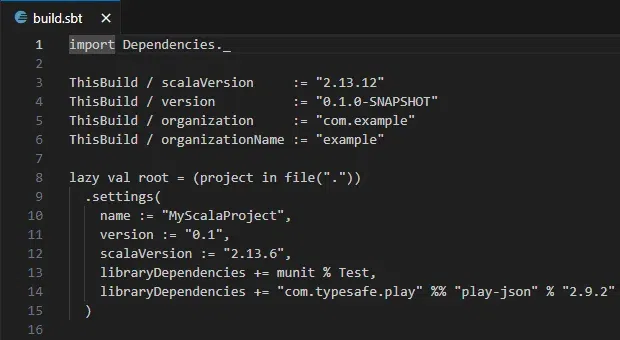|
Scala, a strong language that unites both object-oriented and functional programming techniques has to depend on external libraries to enhance its capabilities. To develop projects seamlessly, there must be efficient handling of these libraries. This is where dependency management becomes important. In this article, we will see the process of adding Scala dependencies with examples and step-by-step procedures.
Setting Up the EnvironmentTo work with Scala, you need to set up your development environment. Ensure you have Scala installed and a build tool like SBT (Scala Build Tool).
1. Create a New Project Using SBTsbt new scala/scala-seed.g8
Inside your project directory, there is a build.sbt file. This file will contain your project’s configuration, including dependencies.
 Creating a Scala Project 2. Define Your Project in build.sbtOpen build.sbt and define your project settings.
Example:
name := “MyScalaProject”,
version := “0.1”,
scalaVersion := “2.13.6”,
3. Add DependenciesDependencies are added under the libraryDependencies setting.
For example, to add the popular JSON library play-json, your build.sbt might look like this:
lazy val root = (project in file(“.”))
.settings(
name := “MyScalaProject”,
version := “0.1”,
scalaVersion := “2.13.6”,
libraryDependencies += munit % Test,
libraryDependencies += “com.typesafe.play” %% “play-json” % “2.9.2”
)
 Adding Dependencies 4. Fetch and Use DependenciesOnce you have defined your dependencies, you need to fetch them.
Run the following command in your project directory:
sbt update
 Updating Project 5. Run Your ProjectRun the following command in your project directory:
sbt run
 Running Scala Project Example 1: Adding Akka HTTP1. Adding Akka HTTP Dependencies libraryDependencies += “com.typesafe.akka” %% “akka-http” % “10.2.7”,
libraryDependencies += “com.typesafe.akka” %% “akka-actor-typed” % “2.6.19”,
libraryDependencies += “com.typesafe.akka” %% “akka-stream” % “2.6.19”
2. Complete build.sbtimport Dependencies._
ThisBuild / scalaVersion := “2.13.12”
ThisBuild / version := “0.1.0-SNAPSHOT”
ThisBuild / organization := “com.example”
ThisBuild / organizationName := “example”
lazy val root = (project in file(“.”))
.settings(
name := “MyScalaProject”,
version := “0.1”,
scalaVersion := “2.13.9”,
libraryDependencies += munit % Test,
libraryDependencies += “com.typesafe.akka” %% “akka-http” % “10.2.7”,
libraryDependencies += “com.typesafe.akka” %% “akka-actor-typed” % “2.6.19”,
libraryDependencies += “com.typesafe.akka” %% “akka-stream” % “2.6.19”
)
3. Implementation Code
Scala
import akka.actor.ActorSystem
import akka.http.scaladsl.Http
import akka.http.scaladsl.server.Directives._
object Example1 extends App {
implicit val system = ActorSystem("my-system")
implicit val executionContext = system.dispatcher
val route = path("hello") {
get {
complete("Hello, Akka HTTP!")
}
}
Http().newServerAt("localhost", 8080).bind(route)
}
Output:
 Running Scala Akka HTTP Example #2 Adding ScalaTest1. Adding ScalaTest DependencieslibraryDependencies += “org.scalatest” %% “scalatest” % “3.2.16” % Test
2. Complete build.sbtimport Dependencies._
ThisBuild / scalaVersion := “2.13.12”
ThisBuild / version := “0.1.0-SNAPSHOT”
ThisBuild / organization := “com.example”
ThisBuild / organizationName := “example”
lazy val root = (project in file(“.”))
.settings(
name := “MyScalaProject”,
version := “0.1”,
scalaVersion := “2.13.9”,
libraryDependencies += munit % Test,
libraryDependencies += “org.scalatest” %% “scalatest” % “3.2.16” % Test
)
3. Test Implementation Code
Scala
package example
import org.scalatest.flatspec.AnyFlatSpec
import org.scalatest.matchers.should.Matchers
class Test2 extends AnyFlatSpec with Matchers {
"A String" should "have the correct length" in {
"Scala".length shouldEqual 5
}
}
Output:
 Running Scala Test Example #3 Adding scala-csv Library1. Adding scala-csv DependencieslibraryDependencies += “com.github.tototoshi” %% “scala-csv” % “1.3.10”
2. Complete build.sbtimport Dependencies._
ThisBuild / scalaVersion := “2.13.12”
ThisBuild / version := “0.1.0-SNAPSHOT”
ThisBuild / organization := “com.example”
ThisBuild / organizationName := “example”
lazy val root = (project in file(“.”))
.settings(
name := “CsvWork”,
libraryDependencies += munit % Test,
libraryDependencies += “com.github.tototoshi” %% “scala-csv” % “1.3.10”
)
3. Implementation Code
Scala
import scala.io.Source
object Example3 {
def main(args: Array[String]): Unit = {
val filename = "data.csv"
val delimiter = ","
val file = Source.fromFile(filename)
for (line <- file.getLines()) {
val fields = line.split(delimiter).map(_.trim)
println(fields.mkString(", "))
}
file.close()
}
}
Output:
 Running Scala CSV ConclusionIt is easy to add dependencies in Scala particularly if you are working with sbt. By defining dependencies in the build.sbt file, you can easily manage and use external libraries, enhancing your project’s capabilities and efficiency. You should be confident with adding and utilizing these kinds of stuffs into your scala jobs using the examples provided.
FAQ’s related to How to add Dependency in Scala?1. What does a dependency mean in Scala?A dependency on Scala is any form of an external library or module that a project has to possess for it to run well.
2. What is sbt and its significance in Scala?Simple Build Tool (SBT) is widely applied as a deployment tool in coding operations such as compilation, dependencies management, packaging apps among others.
3. How do I add a dependency in sbt?The process of adding a dependence on sbt involves including it under libraryDependencies within your build.sbt file.
4. Where do we get our Scala dependencies from?These Scala dependencies are kept mostly in Maven Central and repositories belonging to scala itself.
5. Can I use other build tools apart from sbt?Other alternative build tools for managing scala dependences include; Maven and Gradle. However, when it comes to scala projects most people prefer using sbt since it is the commonest one.
|







